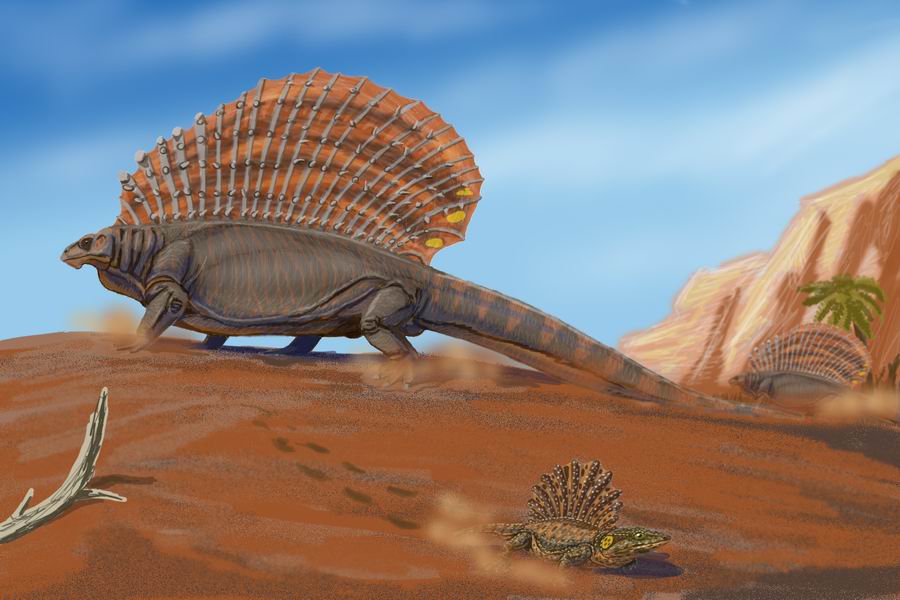- Eupelycosauria
Taxobox
name = Eupelycosauria
fossil_range = LateCarboniferous to LatePermian (non-mammalian)

image_width = 240px
image_caption = "Edaphosaurus ", a Eupelycosaurian
regnum =Animal ia
phylum = Chordata
classis =Synapsid a
ordo =Pelycosaur ia
unranked_familia = Eupelycosauria
unranked_familia_authority = Kemp, 1982
subdivision_ranks = Families and Clades
subdivision =
*Varanopseidae
*Ophiacodontidae
*Edaphosauridae
*Sphenacodontia *
**Sphenacodontidae
**Therapsid a *
***Mammal iaThe Eupelycosauria originally referred to a suborder ofPelycosaur s (Reisz 1987), but has been redefined (Laurin and Reisz 1997) to designate aclade ofsynapsid s that includes most pelycosaurs, as well as all therapsids and mammals. They first appear during theEarly Pennsylvanian epoch (i.e: "Archaeothyris ", and perhaps an even earlier genus, "Protoclepsydrops "), and represent just one of the many stages in the acquiring of mammal-like characteristics (Kemp 1982), in contrast to their earlier amniote ancestors. The defining characteristics which separate these animals from theCaseasauria (also Pelycosaurs) are based on details of proportion of certain bones of theskull . These include a long, narrowsupratemporal bone (in contrast to caseasaurs where this bone is almost as wide as it is long), and afrontal bone with a wider connection to the upper margin of the orbit (Laurin and Reisz 1997).Evolution
Many non-therapsid Eupelycosaurs were the dominant land animals from the latest
Carboniferous to the end of the earlyPermian epoch.Ophiacodontids were common since their appearance, from lateCarboniferous (Pennsylvanian ) to early Permian, but they became progressively smaller as early Permian went by. TheEdaphosaurids , along with theCaseids , were the dominantherbivore s in the early part of Permian, ranging from the size of apig to the size ofrhinoceroses . The most renowned Edaphosaurid is "Edaphosaurus ", a large (10 - 12 ft long) herbivore which had a sail on its back, probably used for regulating heat and mating. Sphenacodontids, a family of carnivorous eupelycosaurs, included the famous "Dimetrodon ", which is sometimes mistaken for adinosaur , and was the largest predator of the period. Like "Edaphosaurus", "Dimetrodon" also had a distinctive sail on its back, and it probably served the same purpose - regulating heat. The Varanopseid family somewhat resembled today'smonitor lizard s and may have had the same lifestyle. [ [http://www.palaeos.com/Vertebrates/Units/Unit390/000.html Paleos Synapsida] ]Therapsids descended from a clade closely related to the Sphenacodontids. They became the succeeding dominant land animals for the rest of the Permian and in the later part of theTriassic , therapsids gave rise to the firstmammal s. All non-therapsid pelycosaurs, as well as many other life forms, became extinct at the end of Permian period.Taxonomy
Classification
* Series
Amniota
** CLASS SYNAPSIDA *
*** OrderPelycosaur ia *
**** SuborderCaseasauria
**** Suborder Eupelycosauria *
***** FamilyVaranopseidae
***** FamilyOphiacodontidae
***** FamilyEdaphosauridae
***** (unranked)Sphenacodontia *
****** FamilySphenacodontidae
*** OrderTherapsida *
** Class MAMMALIAReferences
* Kemp. T.S., 1982, "Mammal-like Reptiles and the Origin of Mammals".
Academic Press , New York
* Laurin, M. and Reisz, R. R., 1997, [http://tolweb.org/accessory/Synapsid_Classification_&_Apomorphies?acc_id=466 Autapomorphies of the main clades of synapsids] -Tree of Life Web Project
* Reisz, R. R., 1986, "Handbuch der Paläoherpetologie – Encyclopedia of Paleoherpetology, Part 17A Pelycosauria" Verlag Dr. Friedrich Pfeil, ISBN 3-89937-032-5External links
* [http://www.palaeos.com/Vertebrates/Units/Unit390/100.html#Eupelycosauria Eupelycosauria]
Wikimedia Foundation. 2010.
